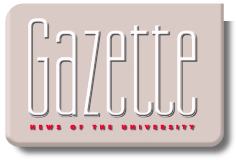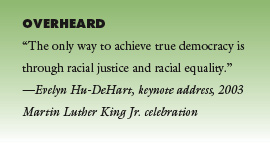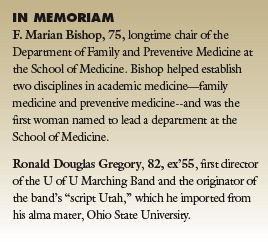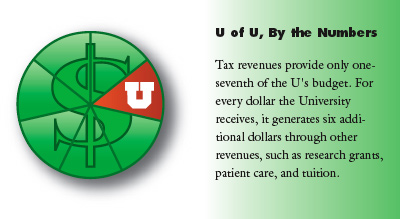|
||||||
 |
||||||
 |
||||||
C’MON,
GET HAPPY |
||||||
If “happy hour” brings to mind cheap beer, sticky floors, and loud conversation, perhaps a visit to one of the monthly “Humanities Happy Hour” soirees is in order. The College of Humanities, those disseminators and stimulators of higher thought, is changing the Salt Lake City after-work climate to something a little more uplifting. Since November, the Humanities Happy Hour has met on the third Thursday of every month at Squatters Brew Pub (147 W. 300 So.) from 5-7 p.m. for conversation, food and drink, and a short, informal talk by a faculty member from the college— an “intellectual hors d’oeuvre.” (An entrée presumably comes with the price of tuition.) Mayor Rocky Anderson BS’73, an alumnus of the college, is the evening’s host, and Robert Newman, the dean of the college, is the toastmaster, usually offering a limerick of his own devising (appropriate for a James Joyce scholar). While food and drink may be typical parts of a happy hour—though this being Squatters, the beer is better than typical and non-imbibers can choose from a selection of other everages, as well—the chance to talk “humanities” informally provides a new twist. The professors have risen to the occasion, offering brief ruminations on such topics as “Learning: The Only Essential Act of Violence” (Ann Darling) and “Happiness in the New Year: An Ancient Greek Perspective”(Jim Svendsen). It can be hard to return to a conversation about, say, “American Idol” after that kind of interlude, which is perhaps the point. Faculty speakers (and students, too, one of whom recently read his impressively crafted poem) come from all departments in the college—communication, English, history, languages and literature, philosophy, and linguistics—and its related programs, including the University Writing Program, Middle East Center, Asian Studies Program, and Tanner Humanities Center. Members of the Humanities Happy Hour—about 220 so far—pay a $100 annual membership fee for the monthly get-togethers ($185 for couples), and the funds go to student programs in the college. Members are alumni of the college, friends, interested city residents, even University administrators— basically, anyone interested in winding down after a hard day and making the humanities more than a book stuck on a shelf. For a taste of a recent hors d’oeuvre, go to “Don’t Know Much About History’: Confronting the Past with Generation Y,” a Happy Hour talk given by Bob Goldberg, professor of history. |
||||||
| THREE PROFESSORS ELECTED TO ENGINEERING ACADEMY | ||||||
Three U of U professors were recently elected to the National Academy of Engineering, considered one of the most prestigious academic distinctions. At least 25 present or former University faculty members have now been elected to oneof the National Academies, which include the National Academy of Sciences, the National Academy of Engineering, and the Institute of Medicine. The recent elections include R. Peter King, professor of metallurgical engineering; Adel F. Sarofim, Presidential Professor of chemical and fuels engineering; and Sun Wan Kim PhD’69, Distinguished Professor of pharmaceutics and pharmaceutical chemistry. |
 |
|||||
King, who was born and raised near a South African gold mine, works to make the processing of minerals more economical and energy efficient. Sarofim studies heat transfer in, and pollution from, combustion systems in order to reduce pollution and increase energy efficiency. Kim, who is also a member of the Institute of Medicine, designs organic substances called polymers for use in delivering medicines more precisely where needed in the human body. Said President Bernie Machen of the three elections,“This is a great tribute to the quality of our faculty and shows how they are respected well beyond Utah’s borders.” |
||||||
| ROOM FOR EMERGENCIES | ||||||
| In the television series “ER,” emergency technicians rush patients on gurneys through open corridors, and health-care workers cluster together for impromptu conversations in spare rooms. In University Hospital’s previous emergency room, such open spaces didn’t exist, with 30,000 patients each year receiving care in an ER originally equipped to handle 22,000 patients a year. “We had just completely outgrown our space,” says Rick Fullmer ex’68, the hospital’s executive director. But with the opening of the George S. and Dolores Doré Eccles Critical Care Pavilion in April, many overcrowding issues have been put to bed. The structure adjoins University Hospital directly to the north and houses the new emergency center on the first floor, a Surgical Intensive Care Unit (SICU) on the second floor, and operating suites and short-stay recovery on the third floor. The hospital is one of only two Trauma I centers in the Intermountain West accredited by the American College of Surgeons, and the new emergency room will expand the hospital’s ability to provide immediate help. The center contains 21 rooms, most of them private, a “fast-track” area with six mini-rooms, and a trauma room that is double the size of its predecessor. The waiting area is much larger, a children’s play area has been added, and AirMed has its own area, with large windows to monitor the weather.“The ER has really been made possible by a $3 million gift from Bill BS’54 and Pat BS’62 Child,” Fullmer notes, and the center will bear their names. On the second floor, the SICU has increased from 12 to 26 beds (with room for six more, as needed), making it the largest of its kind in the region. High-tech, glass-walled rooms allow nurses and other professional staff to monitor critically ill patients. And, on the third floor, 23 private, short-stay recovery rooms— along with four new operating rooms in the main hospital, and the ability to add two more—will help meet the demand for both elective and trauma surgeries. (In 2001, University surgeons performed more than 10,000 surgeries.) “The hub of University Hospital is built around very sick patients, so it was critical for us to expand our space and services,” Fullmer says. “We’ve received great support from the community— and from more than 2,000 hospital employees and many faculty members in the School of Medicine— and we’re very grateful for it.” When the new cancer hospital is completed in July 2004, the “hospital” will actually be a three-facility system that includes the 425- bed University Hospital, the 90-bed Neuropsychiatric Institute, and the 50-bed cancer hospital. University Hospital & Clinics logs more than 800,000 inpatient and outpatient visits annually. |
||||||
 |
||||||
| HEADING TO OXFORD |  |
|||||
| In the fall, biochemistry graduate Gretchen Domek BS’03 will head to Oxford University to begin her two-year term as a Rhodes Scholar. Domek was chosen in December as one of 32 Americans to receive the prestigious scholarship for international graduate study, which covers educational costs, travel expenses, and a living and vacation stipend. Continuum readers may remember meeting Domek in the Spring 2000 issue, where she was one of six students profiled because they received scholarships through the “Generations of Excellence” fund-raising campaign that recognized the University’s sesquicentennial anniversary. Domek made good use of her time at the University, working in a biology lab, spending two years on the cross-country ski team, participating in the Honors Program, and volunteering both on and off campus. Program, and volunteering both on and off campus. Her well-roundedness fit well with the Rhodes criteria, which, as writer Ann Bardsley BA’84 pointed out in her Winter 2002 Continuum article on the Rhodes program, focus not just on academic excellence but also on energy, courage, “devotion to duty,” and even “kindliness, unselfishness, and fellowship.” |
||||||
Domek, whose mother died of cancer in 2000, credits the U for providing challenging programs and committed faculty members. “Individuals don’t win the Rhodes Scholarship,” she says. “It’s really the combined effort of the community and the University.” An out-of-state student, Domek says the U “welcomed me with open arms. The weekend I was flown out here to look at the school, one of the first people I met was the president. We’ve kept in touch since then. I remember once, at a ski meet, seeing Bernie and his wife, Chris, standing there in the cold with the few other people who attend cross-country ski meets. It’s pretty unusual that a university president is going to do that.” |
||||||
 |
||||||
| 2003 LEGISLATIVE WRAP-UP | ||||||
|
In addition, though enrollment at the U increased this year, there was no enrollment growth funding. The state will be $15 million behind in enrollment growth funding by July 1. As a way to manage enrollment, the University has temporarily increased admission standards, raising the minimum index score—which corresponds to a student’s ACT score and high school grade point average (GPA) —from 90 to 92. The minimum ACT score is now 18 and the minimum GPA is 2.6. The Marriott Library did not receive funding for its renovation project, but the U was given a commitment that the project would be the legislature’s highest capital funding priority next year. And the University received additional funding for health and dental benefits, offsetting most of the cost increases from higher insurance premiums that would have been passed on to employees. Prior to the legislative session, the Board of Regents approved tuition increases: a 4.5 percent increase in tier-one tuition (an amount set by the regents for the entire system), and a 7 percent increase in tier-two tuition (an additional amount suggested by individual schools) for the University. A portion of the increased tuition revenue will be set aside for needbased student financial aid. |
||||||
 |
||||||

 Utah’s weak economy
led to additional state budget
cuts during the 2003 legislative
session, and state-supported
institutions of higher
education, including the U,
took their share of the hit.
The University’s ongoing
state funding was reduced
by $3.4 million.
Utah’s weak economy
led to additional state budget
cuts during the 2003 legislative
session, and state-supported
institutions of higher
education, including the U,
took their share of the hit.
The University’s ongoing
state funding was reduced
by $3.4 million.